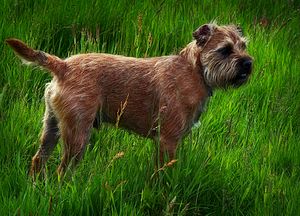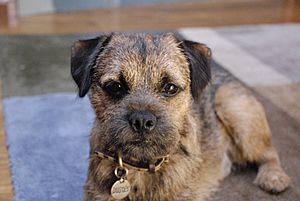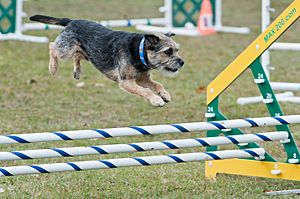Border Terrier facts for kids

Male Border Terrier
|
|||||||||||||||||||||||||||||
| Origin | UK - Scotland / England | ||||||||||||||||||||||||||||
|---|---|---|---|---|---|---|---|---|---|---|---|---|---|---|---|---|---|---|---|---|---|---|---|---|---|---|---|---|---|
|
|||||||||||||||||||||||||||||
|
|||||||||||||||||||||||||||||
| Domestic dog (Canis lupus familiaris) | |||||||||||||||||||||||||||||
The Border Terrier is a small dog breed with a rough coat. It belongs to the terrier group. These dogs were originally bred to hunt foxes and other small animals like vermin. The Border Terrier is related to other breeds like the Dandie Dinmont Terrier and the Bedlington Terrier.
This breed was officially recognized by The Kennel Club in Great Britain in 1920. Later, the American Kennel Club (AKC) recognized them in 1930. Border Terriers were bred to have legs long enough to run alongside horses and foxhounds during hunts. They also needed small bodies to fit into fox burrows. This allowed them to chase foxes out for hunters. The larger foxhounds could not do this job.
Border Terriers are very popular in the United Kingdom. In 2006, they were the tenth most registered dog breed there. By 2008, they had moved up to eighth place. While they were once used for hunting in packs, they are now often loved as family pets. They are especially good at catching rabbits and other small animals.
Contents
What Does a Border Terrier Look Like?
Appearance of a Border Terrier
Border Terriers are easy to spot because of their "otter-shaped" heads. They have a wide skull and a snout that is not too long. Their teeth are strong. Their ears are V-shaped and fold down towards their cheeks.
Their coats come in several common colors. These include grizzle-and-tan, blue-and-tan, red, or wheaten. They have short whiskers. Their tail is usually short, thick at the base, and gets thinner towards the end.
These dogs have narrow bodies and good proportions. Male Border Terriers usually stand about 33 to 41 centimeters (13 to 16 inches) tall at the shoulder. They weigh around 5.9 to 7 kilograms (13 to 15.5 pounds). Females are a bit smaller, standing about 28 to 36 centimeters (11 to 14 inches) tall. They weigh about 5.2 to 6.4 kilograms (11.5 to 14 pounds). They make great family pets because they are so adaptable.
A Border Terrier has a double coat. This means it has two layers. The inner layer is a short, soft, and dense undercoat. The outer layer is harsh and wiry. This outer coat protects them from weather and dirt. It lies close to their body and is not curly or wavy.
This special coat needs care. It usually requires hand-stripping twice a year. This process removes dead hair. After stripping, it takes about eight weeks for the new top coat to grow back. Some Border Terriers only need weekly brushing. While many are seen with short hair, some owners prefer their hair a bit longer.
How Do Border Terriers Behave?
Temperament of a Border Terrier
Border Terriers are generally calm and friendly dogs. They are rarely aggressive. While they can sometimes be stubborn, they are good with children. However, they might chase cats or other small pets.
These dogs are good at activities that involve tasks. They can jump surprisingly high and run very fast for their size. They are great at agility training, especially jumps and see-saws. They learn tricks quickly and are very trainable. In recent years, they have been bred to be calmer. This makes them more suitable for living in apartments, as long as they get enough exercise.
Border Terriers are smart and like to please their owners. But they also think for themselves. This independent thinking helped them when they were hunting foxes underground. Because they love people and have a calm nature, they make excellent therapy dogs. They are especially helpful for children and older people. Sometimes, they even help people who are blind or deaf. It's important to train them with commands from a young age.
These dogs can easily adjust to new places and situations. They handle temporary changes well. If they grow up with cats, they will usually get along with them. But they might chase other cats and small animals like mice, birds, rabbits, squirrels, rats, and guinea pigs.
Border Terriers are very independent and loyal to their families. Some are known to protect their homes. They also have a very strong sense of smell.
They love to sit and watch what is happening around them. When you take a Border Terrier for a walk, they will often stop to sit or lie in the grass and observe their surroundings.
Health of Border Terriers
Border Terriers are generally healthy dogs. However, like all breeds, they can have certain genetic health problems. These include:
- Hip dysplasia: A problem with the hip joint.
- Perthes disease: A problem with the hip bone.
- Various heart defects: Problems with the heart that are present from birth.
- Juvenile cataracts: Cloudiness in the eye lens that can affect young dogs.
- Progressive retinal atrophy: An eye disease that can lead to blindness.
- Seizures: Sudden bursts of uncontrolled electrical activity in the brain.
- Canine epileptoid cramping syndrome (CECS): A condition that causes muscle cramps.
A survey by the UK Kennel Club found that Border Terriers usually live for about 14 years. Some have even lived to be over 22 years old!
What are Earthdog Trials?
Border Terriers have earned more Earthdog titles from the American Kennel Club (AKC) than any other terrier breed. An AKC earthdog test is not real hunting. It's a special exercise where terriers go into narrow wooden tunnels buried underground. These tunnels are about 23 centimeters (9 inches) wide and have turns. The dogs bark or scratch at caged rats that are safely behind wooden bars.
These tests show that the dogs still have their natural hunting instincts. This is what the people who first bred these dogs wanted. Earthdog tests are popular in the U.S. and some European countries. This is because even larger dogs can fit through the tunnels easily. Also, the dogs are safe and don't get hurt, and no digging is needed. Many Border Terrier owners think it's important to test their dogs' instincts. These tests are also very satisfying for the dogs themselves.
History of the Border Terrier
The Border Terrier was first called the Coquetdale Terrier or Redesdale Terrier. These names came from the areas where the breed developed. But by the late 1800s, it became known as the Border Terrier. This was probably because of its long history with the Border Hunt in Northumberland, a region near the border between England and Scotland. The breed shares its family tree with the Bedlington Terrier and the Dandie Dinmont Terrier.
The Kennel Club officially recognized the Border Terrier as a breed in 1920. The Border Terrier Club was also formed in the same year. The main job of these dogs was to chase foxes out of their dens. They also hunted rodents. Sometimes, they were even used to hunt otters and badgers.
The very first Border Terrier registered with the Kennel Club was a dog named The Moss Trooper. He was registered in 1913. The Border Terrier was not accepted for formal recognition in 1914, but it finally got its official spot in 1920. The first set of rules for the breed was written by Jacob Robson and John Dodd. Jasper Dodd became the first President of The Border Terrier Club.
Images for kids
See also
 In Spanish: Border terrier para niños
In Spanish: Border terrier para niños







